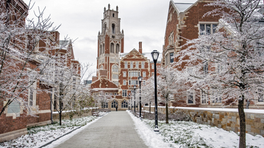Admission Rates for Select Texas Universities
- Ryan Murphy

- Apr 23, 2016
- 3 min read

Last week, I wrote about acceptance rates for the Class of 2020 for the Ivies, Stanford, MIT, and UT-Austin. This week I will provide general acceptance rates for select universities in Texas. These schools have followed a similar trend that I noted last week. In other words, admission rates were lower for recent years when compared to earlier ones, and for the most part, more students are applying.
Rice University (Houston):
Rice has not released its Class of 2020 acceptance rate, but an article from The Rice Thresher from last April reveals the admissions trend for the past fifteen years (Classes of 2004-2019). Amazingly, back for the Class of 2004, Rice only received 6802 applications, of which they accepted 1583, making their acceptance rate 22%. Skip to the Class of 2019 (fifteen years later!), and you will see that Rice received ~17900 applications, of which they accepted 2650, making their acceptance rate 14.9%.
What is telling about Rice’s admission rate history is that the trend we see with this one university is happening all over the country. For students in the Class of 2004, applying to college was much more focused, limited to 2-3 schools. However, now students are applying to 10-15 schools, including “reach,” “on target,” and “safety net” ones. As more students apply to more schools, competition increases, but, as you can see from the raw number of Rice’s acceptances, the number of students admitted hardly changes. Rice, over the course of fifteen years, only increased their acceptances by ~1,100 students. What does that tell you? Well, don’t hold your breath that the rising number of applications will force universities to accept more students. You need to put together the strongest application possible.
Texas A and M (College Station):
Texas A and M (TAMU) also has not released its Class of 2020 acceptance rate. In fact, they will not do so until some time in November 2016, once students have enrolled in classes. They have released, however, their admission rates for the past several years. For the Class of 2019, 32,622 students applied, of which 21,060 were accepted, making the acceptance rate 65.31%. For the Class of 2018, 30,874 students applied, of which 21,888 were accepted, making the acceptance rate 70.89%. While TAMU accepts many more students than Rice does, the trend still shows that more students are applying each year, making the acceptance rate decrease.
Baylor (Waco):
Baylor, too, has not released its Class of 2020 acceptance rate, but its blog, Baylor Proud, has released an article stating that the Class of 2020 will be Baylor’s most competitive. A post from 2015 states the exact same thing, so you can see that there’s a trend here as well: more students are applying to Baylor, and Baylor is still taking the same number of students. Also, the post states that the admission rate (at the time the post was written) for the Class of 2019 was 44%, “a full ten points lower than last year.” So the increase in interest in Baylor seems a bit higher than average, especially for it to cut down its admission rate by 10%.
SMU (Dallas):
SMU, like the other schools listed above, has not released information about the Class of 2020 admissions, but it does have a useful guide on its website, which shows a trend similar to the previous schools. In other words, for the Classes of 2009-2019, SMU received an overall increase of ~6,000 applications, basically doubling its applications over the past decade. Unlike Rice, however, SMU has been more lenient with admitted students, so its acceptances have increased from 4,076 to 6,360 over the decade, allowing for the acceptance rate to change from 67.4% to 48.95%.
What is the takeaway?
Hopefully it is becoming more apparent that seniors should treat college admissions with utmost importance, especially as more students become interested in schools that for the longest time have flown under the admissions radar. Rice, for example, has changed from one of the “Ivies of the South” to a more prestigious university all over the nation, hence the small acceptance rate. Baylor, too, is seeing tremendous increases in how many students apply, suggesting that private universities once considered “on target” or even “safe” are becoming deceptively more competitive.
Thankfully we at B2A are experts in helping students get into Texas colleges and universities, and we have several different services and programs that can help high school seniors (and even younger students) get to their dream Texas schools. Do take the time to make the right choice and don’t fall behind in your application process!































